All your customers have email addresses. They use their emails every day.
According to the below chart from Statista based on stats from the email marketing company BlueHornet, almost 33.8% of American consumers check their emails throughout the day.
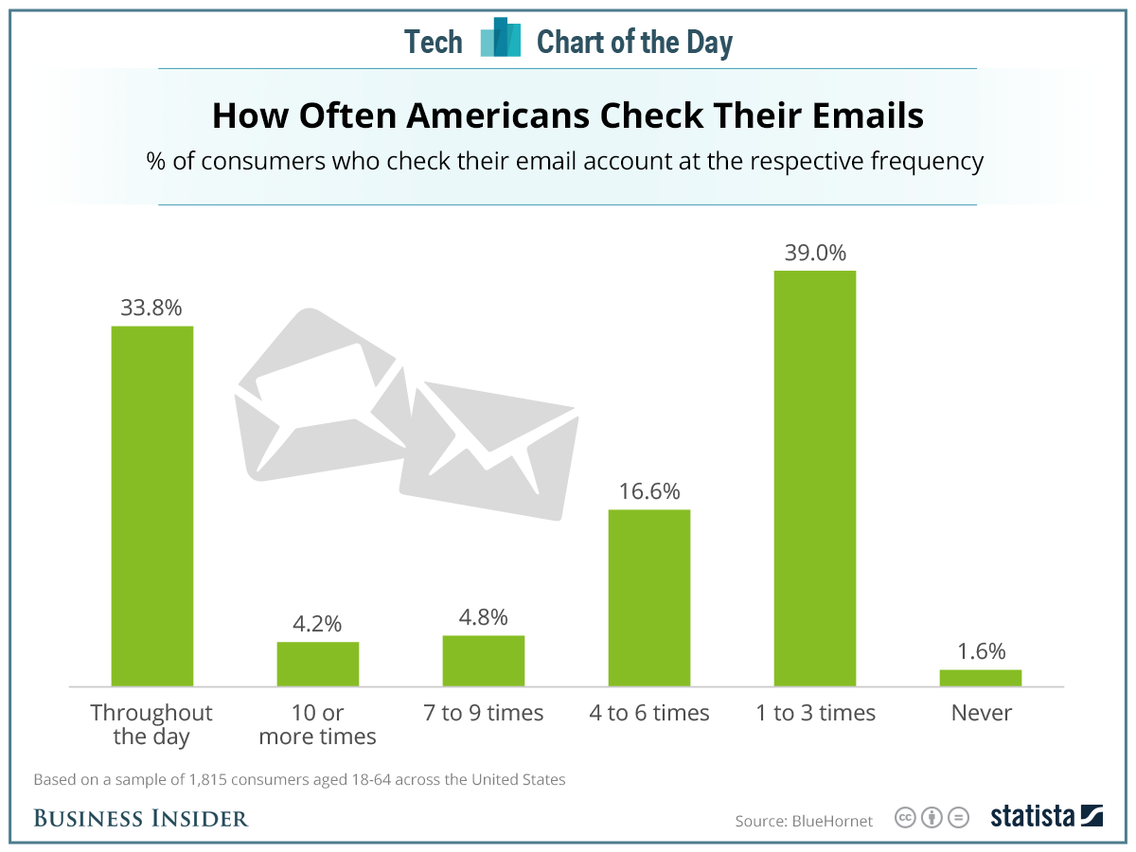
Mobile is a huge reason why many people check their emails more these days.
Consumers have their smartphones with them at all times, everywhere they go. That means, they can immediately check new messages when they arrive.
The above chart shows that 1.6% of email users never check their emails once a day.
Understanding Email Marketing
Email marketing means sending emails to prospects and customers.
The purpose of email marketing is to convert prospects into customers and turn customers into loyal fans.
Email marketing generates higher returns than every other marketing strategy.
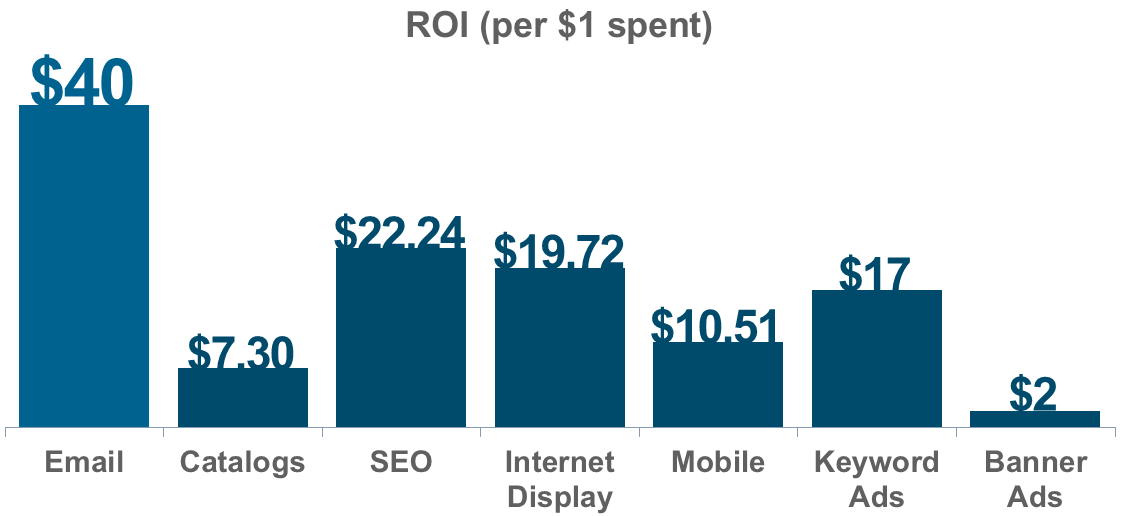
In this article, you’ll learn the most important aspects of email marketing.
I’ve broken this article down to different sections.
- Why Email Marketing Is Important
- How to Create Your First Email Marketing Campaign
- How to Build a Huge Email List
- How to Personalize Your Email Marketing Campaign with Segmentation
- The Things I Do to Improve My Email Open Rates
Introduction: Why Email Marketing Is Important
Email has been an important part of the web for years. You need email for everything you want to do online today. Most websites ask for your email when you’re signing up.
In the last decade, we’ve witnessed the rise of powerful social media platforms like Facebook, Instagram, WhatsApp, Twitter, LinkedIn, etc.
Despite a lot of people using these platforms, email remains the best place for businesses to develop strong relationships with consumers.
Email marketing should come first before any other marketing strategy.
Here are some reasons why you should make email marketing a top priority:
Consumers prefer to communicate with brands through email. According to a study by Marketing Sherpa, 72% of consumers say they like to receive promotional messages from brands through email.
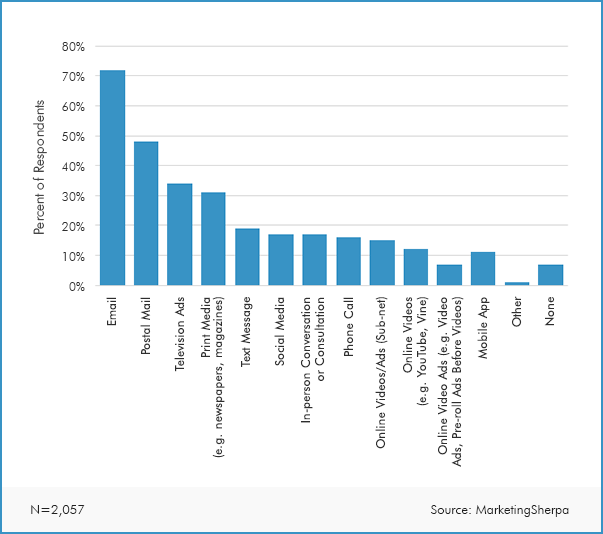
Email is more convenient for consumers. The messages they receive through emails are more personalized than what they see on other marketing channels like social media, websites, etc.
Email helps brands reach more consumers than other marketing channels.
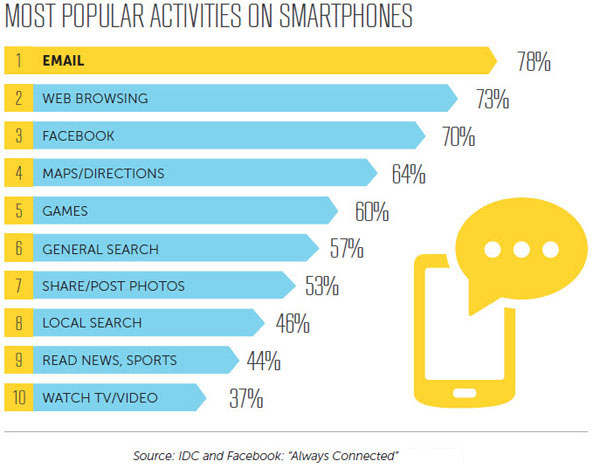
Prospects won’t visit your website regularly. There are hundreds of millions of websites online. You don’t expect prospects to visit yours all the time.
Prospects may also miss your messages on social media. They are probably following tens, or hundreds of other brands on social media and they aren’t always online to see your latest social media updates.
Email is the only true way to ensure that prospects see your messages most of the time. They are unlikely to miss your messages because they’ll see it whenever they check their email. Circle Surrogacy, one of the top surrogacy agencies in the United States only asks for the email address of potential egg donors during the sign-up process.
Sometimes, I go back to unread messages I received weeks ago.
Email is an inexpensive way to reach prospects and customers. Organic reach on Facebook is gone. You have to pay for your Facebook fans to see your posts.
It’s also tough to compete on Twitter and other social media platforms.
But with little investment, you can reach prospects and customers on email.
Chapter 1: How to Create Your First Email Marketing Campaign
You need to collect emails. Not just emails from random people. You need to collect emails of your prospects and customers. These are the people who are interested in your products and services.
Some marketers buy email lists because they can’t wait to build up their lists. Never buy an email list from anyone.
The email list you buy has probably been sold to thousands of other marketers.
The people who own those emails don’t even know you and your business. Some have abandoned their emails because of spam messages they receive from individuals and companies they don’t know.
Don’t add emails from business cards to your list. Because those people gave you their business cards doesn’t mean they want to be in an email list.
Collect emails online. Preferably on your website.
You need an email marketing service. There are lots of email marketing services out there.
I recommend that you use OmniKick with an email marketing service.
OmniKick collects emails on your website and stores them with your email marketing service. Email marketing services don’t do a great job when it comes to the collection or capture of emails. They are only good at storing emails and sending messages.
By using OmniKick on your website, you’ll be able to collect lots of emails on your site.
Here are some email marketing services to use with OmniKick.
1. MailChimp
MailChimp was an underdog some years ago. Today, it’s one of the most popular email marketing services. MailChimp is free for businesses with less than 2,000 subscribers.

Paid plans start at $10 per month. It can go as high as $30 for 2,5000 email subscribers. Here’s an in-depth take on Mailchimp pricing with all available plans and offers.
You pay more as your email list gets bigger.
MailChimp works well with OmniKick.
2. ConvertKit
ConvertKit is another wonderful email marketing service. You can do a lot of complex stuff with it.
For example, you can set up autoresponders that will send messages to your subscribers for months to come. You set it up once, and it’ll send emails at the predefined times, days, weeks or months you want.
ConvertKit is affordable at $29/month for up to 1,000 subscribers. It’s $49/month for 1,000 to 3,000 subscribers. ConvertKit allows you to send unlimited emails per month.
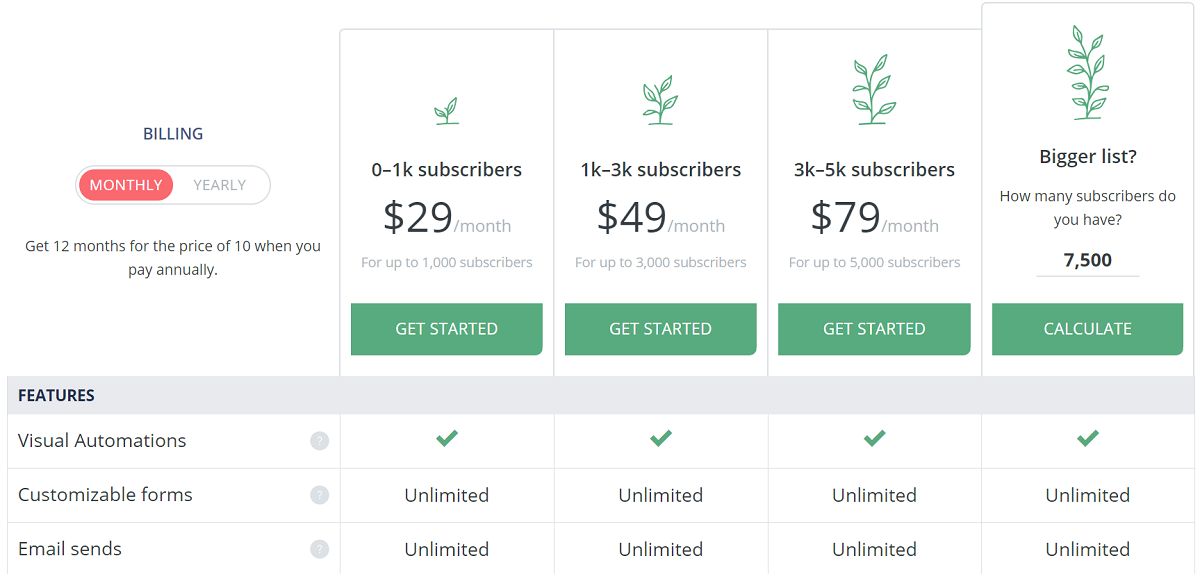
ConvertKit is the ideal email marketing service for online creators like authors, professional bloggers, and speakers.
3. InfusionSoft
InfusionSoft is a full CRM system and email marketing solution for small and medium-size businesses. InfusionSoft is highly advanced and more expensive than MailChimp and ConvertKit.
It does a lot more than you can get from those two.
If you have a B2B business and it takes weeks or months for a prospect to convert, InfusionSoft may be the perfect email marketing service for you. You will be able to interact with potential leads and score them based on their interests, and readiness to convert.
If you have up to 1,500 subscribers in your email list and want to use CRM, you’ll be looking at paying around $247/month.
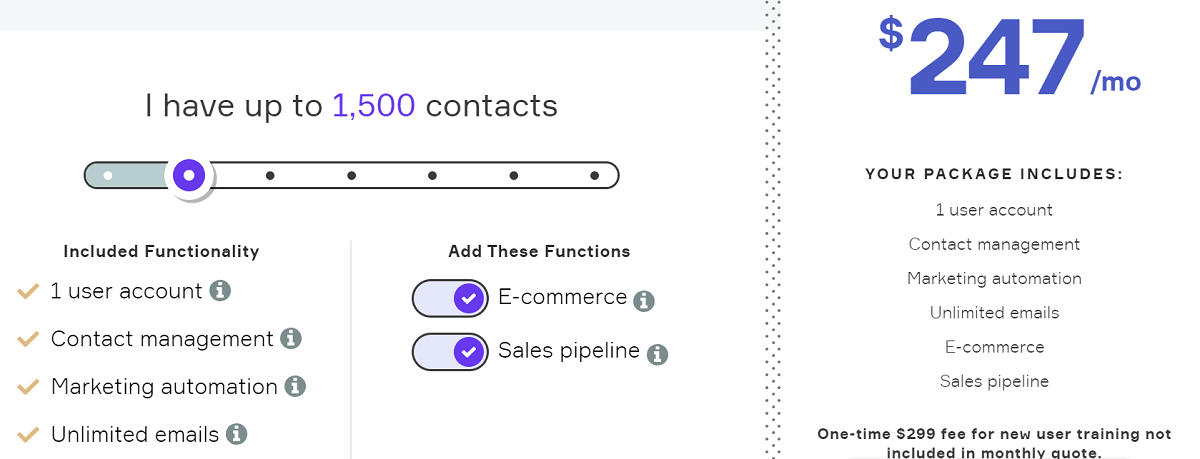
That may seem expensive to you, but it’s worth it if you sell products or services worth over $500.
Comparing InfusionSoft to MailChimp or ConvertKit is like comparing Rolls-Royce to Toyota.
OmniKick integrates well with InfusionSoft.
4. HubSpot
HubSpot is an all-in-one marketing software. Its email marketing service is one of the many features it has.
Here are some things HubSpot does:
- It’s a blogging platform.
- It lets you create landing pages.
- It helps you manage your leads.
- It offers various kinds of marketing analytics.
- It helps with SEO.
- You can monitor brand mentions on social media.
- It has an email marketing software.
Want a complete platform that manages your whole digital marketing campaign? Choose HubSpot.
But, HubSpot isn’t cheap at $800/month.
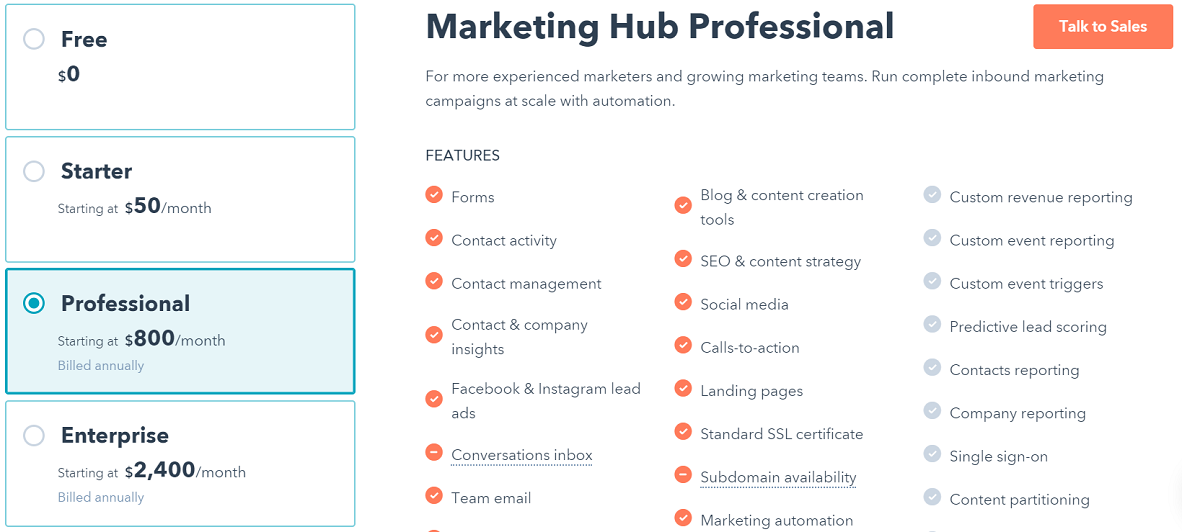
You can manage 1,000 subscribers on this plan. You’ll have to pay $50 per additional 1,000 subscribers.
I don’t recommend HubSpot to small businesses.
OmniKick is also compatible with HubSpot.
5. ActiveCampaign
ActiveCampaign is a wonderful email marketing service that lets you send emails based on customer actions. You can send super personalized and beautiful emails with ActiveCampaign. It also comes with a CRM system.
ActiveCampaign is cheap when you pay yearly. For example, their Plus plan is $70 for 1,000 subscribers when you pay monthly. It drops to $49 per month when you pay yearly.

You can use OmniKick with ActiveCampaign.
6. GetResponse
GetResponse lets you send high-quality, responsive emails and autoresponders. It also comes with a superb A/B testing capability. GetResponse allows you to send targeted email campaigns.
It’s affordable at $15/month for 1,000 subscribers.
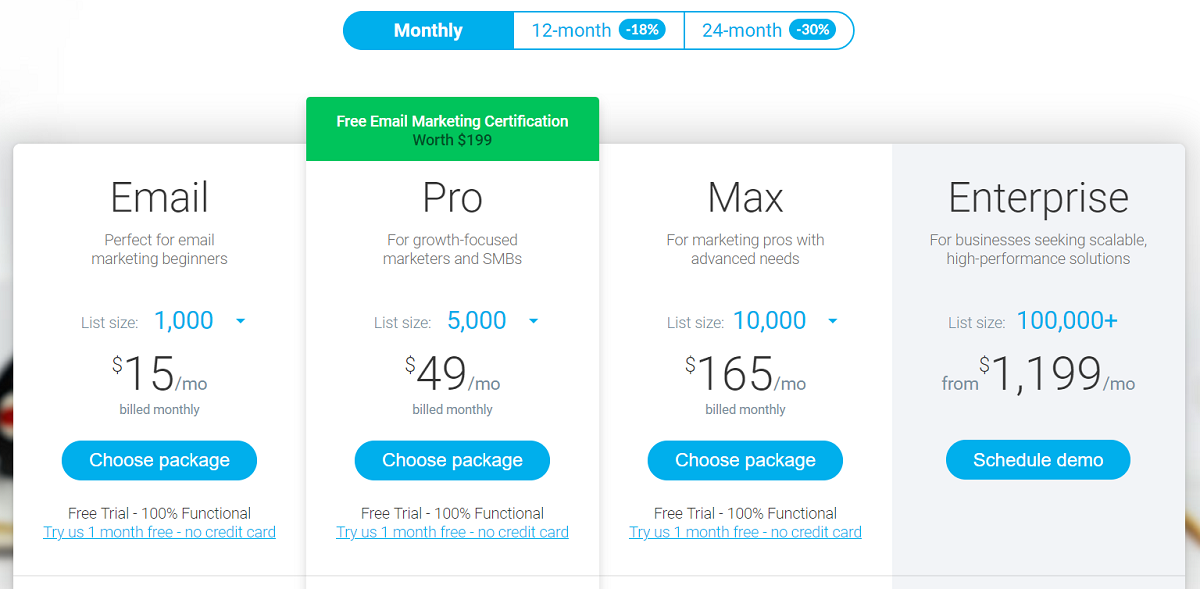
GetResponse is a great email marketing service that works well with OmniKick.
But don’t expect the kind of quality you’ll get from decent services like MailChimp and ConvertKit.
MailChimp and ConvertKit are my favorites.
You can start creating your email campaigns after paying for one of these email marketing services. MailChimp lets you start for free.
These services have instructions on their sites. So, you shouldn’t find it difficult setting up your email campaign.
Chapter 2: How to Build a Huge Email List
It’s time to start collecting emails on your website. But prospects and customers won’t give you their emails because you asked. There has to be a great reason.
What’s in it for them?
People won’t sign up because you use our tool, OmniKick with an email marketing service. These tools only help you collect emails. They don’t convince people to sign up.
Your offer is what will convince people to join your email list. It should be so compelling that prospects won’t wait to give you their email addresses.
This offer is what digital marketers call a lead magnet?
Lead Magnet Examples
A lead magnet is what you offer visitors in exchange for their email addresses. A lead magnet is the most effective way to collect emails.
Every business needs a lead magnet.
Here are some popular lead magnet examples:
- A checklist
- A toolkit
- A web app
- An eBook
- An industry reports
- A webinar
- An email course
- A giveaway
- A free trial
- A case study
- Free consultation
These are just some lead magnet examples.
How to Create a Great Lead Magnet
Lead magnets can help you collect lots of emails. But you can’t just create any lead magnet and expect visitors to give you their email addresses.
Your lead magnet should be great. It should be special.
Your Lead Magnet Should Be Easy to Read or Use
Let’s assume your lead magnet is an eBook. It doesn’t have to be a 450-page eBook. Prospects want something they can quickly download and learn a few important things from it.
The eBook should be well outlined. It should be well-designed.
Your Lead Magnet Should Help Prospects Take Action
Whatever your lead magnet is, whether it’s an eBook, a toolkit or a case study, it should help people start taking action immediately.
Don’t make it hard for prospects to use what you’ve just given to them.
If the lead magnet is a tool, it should be easy to use.
If it’s an eBook, write it in a way that makes it easy for prospects to start acting. For example, include some action steps.
If it’s a case study, ensure that you explain the steps and process you took to prospects.
Your Lead Magnet Should Improve Prospects’ Lives
Your lead magnet should have a noticeable impact on your prospects’ lives. Your prospects should be able to look back weeks or months later and credit your lead magnet for making their lives better.
Your lead magnet should be as valuable as your products or services. Prospects should discover something they don’t know before. Or, they should be able to do things they couldn’t do before.
Your Lead Magnet Should Be Relevant to Them
Don’t create a lead magnet your prospects don’t need.
A great lead magnet is for your prospects. It’s a solution to their problems. It provides the answer to their questions.
Your prospects should find your lead magnet relevant and useful.
Your Lead Magnet Should Available Immediately
Prospects shouldn’t wait before they receive the offer you promised them. Give them immediately they give you their emails.
It should be instant.
Prospects should see a “Success Message” that tells them they’ve subscribed and a link where they can download the offer.
Don’t make them wait.
Your Lead Magnet Should Be Unique
Your prospects shouldn’t find the same type of lead magnet on your competitors’ sites.
Your lead magnet should contain information prospects can only find on your website. It should be so unique and interesting that your competitors may even want to opt-in too.
Here’s one example:
Bidsketch proposal software lets marketers create, electronically sign, and track professional looking client proposals in less time compared to other options. Bidsketch created a proposal template kit and offered it for free.
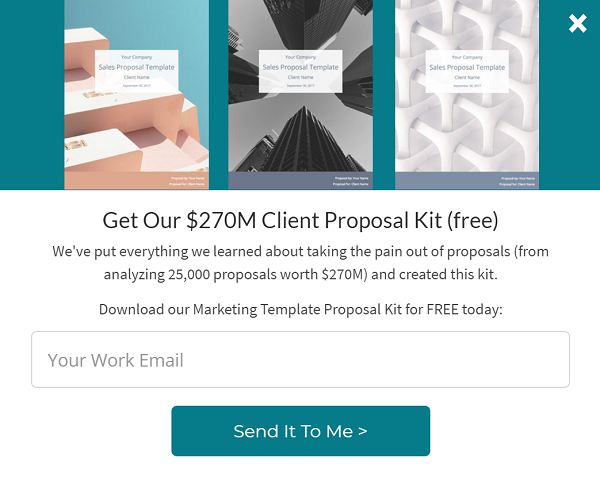
Bidsketch’s lead magnet is unique. You can’t get the information elsewhere.
It’s available for instant download upon giving them your email address. It helps prospects take action.
How to Create an Awesome Optin Form That Converts Visitors
When your lead magnet offer is ready, the next step is to create an opt-in form and put it on your website.
Having a great lead magnet is crucial. Your opt-in form should be well-developed too.
A bad opt-in form could prevent visitors from giving you their email addresses.
Here are the things you need to develop an amazing opt-in form that converts visitors.
- A captivating headline: Your headline should capture the attention of visitors. It should make them pause and subscribe. The headline should contain a big benefit your site’s visitors won’t want to miss.
- A clear, powerful description: The description should enchant visitors. If the headline had gotten 40% of their attention, the description should get the remaining 60%. The description should be short, clear and powerful.
- Include an attractive image: Including a photo of an attractive person could boost conversions. Use an image that invites attention to the form. The image could be anything. Make sure the image is something your prospects will respond to.
- Make the form simple: Don’t ask for too much in the form. Ask for their first names and email addresses. Web users don’t like filling forms.
- Use a powerful call-to-action button: Your call-to-action button is the button visitors click to confirm they’ve filled your form. Use the right words in this button. Don’t use the words “Submit,” “Sign Up” or “Click Here” because they are too common on the web. Your call-to-action button should have non-generic words. Use a powerful color that draws attention to the button.
Chapter 3: How to Personalize Your Email Marketing Campaign with Segmentation
According to DMA, 77% of email marketing ROI came from segmented, targeted, and triggered campaigns.
Segmented emails are more targeted and relevant to their recipients. When you segment your emails, your subscribers feel like you’re talking to them and not a random person.
Email segmentation is the process of breaking subscribers into different categories or groups based on their interests, history with your business, and more.
You can’t send the same type of email message to your complete list and expect the same responses from all of them.
Some are loyal fans. Some are not.
Some have forgotten that they even subscribed to your email list. You have to remind them from time to time.
Email segmentation helps you develop a better and stronger relationship with each subscriber in your email list.
Email Segmentation Boosts Revenue
You’ll earn more when you segment your email list.
Look at the below image based on a study about email segmentation.
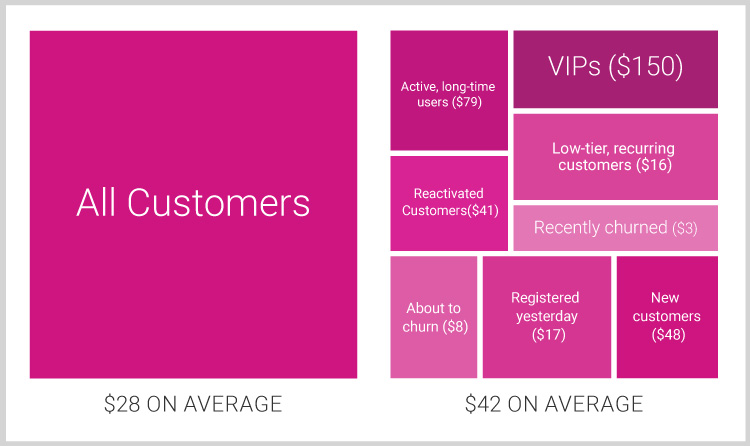
It shows that companies increased the average value of their customers when they do email segmentation.
Looking at the above image, you can see that the VIPs are the most valuable customers. They are valued at $150 on average.
Customers who recently churned have the lowest average value. They are valued at $3 per customer.
By segmenting your email list, you can focus more of your time and effort on high-value customers and less on low-value customers.
Email segmentation lets you allocate your business resources on where they matter most.
Email Segmentation Helps You Write Messages That Resonate with Subscribers
It’s hard to write for everyone in one email message. A single message is likely to resonate more with some prospects than others.
All subscribers want to receive messages that resonate with them.
Through email segmentation, you can learn a lot about your prospects and customers and send them emails they will find relevant and useful. You can write emails that entice subscribers to click and act.
How to Segment Your Email List
The more you know about an email subscriber, the easier it is to segment them.
So, how do you segment your email subscribers?
Here are the top ways to do that:
- The page they signed up: Which page was the subscriber visiting before signing up? Make the lead magnet related to the topic of each page. If a visitor was visiting a page about LinkedIn marketing and your opt-in offer is about the same topic, you can continue to send them emails related to LinkedIn marketing.
- New subscribers: The messages you send to new subscribers should be different from the ones you send to old subscribers. Send new subscribers welcome emails. Send them a series of messages that’ll help them remember your brand.
- Interests: If your subscribers are clicking some messages related to a particular topic more than the others, it tells you their interests. Your subscribers have different interests. Some may be interested in shoes while others may like shirts. Send them messages related to their interests.
- Location: If you know the locations of your subscribers, you can also send them messages related to their areas.
- Shopping Cart Abandonment: Some customers won’t complete their shopping carts. Send them emails that remind them to complete the checkout process.
- Open rate: Subscribers who open and read your messages regularly should be rewarded for their loyalty. Active subscribers deserve more. Give them discounts. Give them some exclusive information that will keep them opening your emails.
- Inactivity: You can turn an inactive subscriber into an active subscriber. Remind inactive subscribers they haven’t opened your emails for a while. Give them a mouth-watering offer that will turn them into loyal fans. You can send them a series of messages over many weeks. Your messages should be so interesting that they don’t want to miss them.
- Old customers: Segment customers by past purchases. Old customers tend to become more loyal than new customers. Send them emails that show you appreciate their loyalty. Give them some bonuses they won’t get from your competitors.
- Amount Spent: You know customers who had spent certain amounts on your website. Whether they are new or old, customers with higher spending should qualify for more benefits than customers with lower spending. Send them email messages that show you recognize and reward them.
Chapter 4: How to Improve Your Email Open Rates
One of the hardest parts of email marketing is getting people to open your messages. You have to get people’s attention inside their inbox.
Lots of businesses and individuals send your subscribers messages. Your email is competing with every other message. Attention is scarce online.
If your subscribers say they want to check their emails for ten minutes, the time isn’t enough to read all the unread emails they have.
You need to ensure that your emails get opened and read.
1. Keep Your Email List Fresh
Most new subscribers are excited to join your email list. As time goes by, some of these subscribers will become less interested in your messages.
Some of these inactive subscribers are no longer interested in reading your emails.
If a subscriber hasn’t opened your email in 180 days, they’ve probably lost the enthusiasm they had when they signed up. Maybe they don’t need your product or service again. For example, a prospect of Elville and Associates, a Maryland law firm, who subscribed months ago may have moved on today.
Your average email open rate will be low if the number of your disinterested subscribers is high.
You need to delete those old subscribers who are no longer reading your emails. Doing that keeps your email list fresh.
Email service providers like Gmail and Outlook are watching your open rates. If your open rate is too low, they may start sending your email messages to the spam folders of their users.
You may send a message to inactive subscribers. Let them know that they haven’t opened your emails for months.
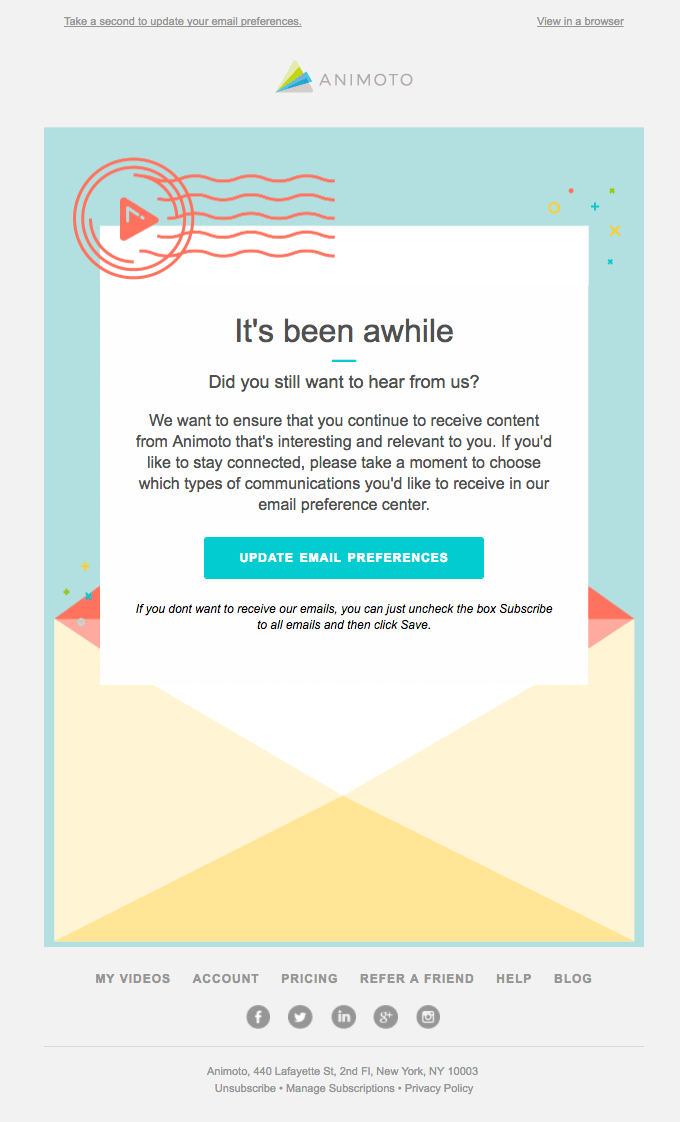
Some inactive subscribers may still want to be part of your email list.
If they still don’t open your emails, it may be time to say goodbye and delete them from your list.
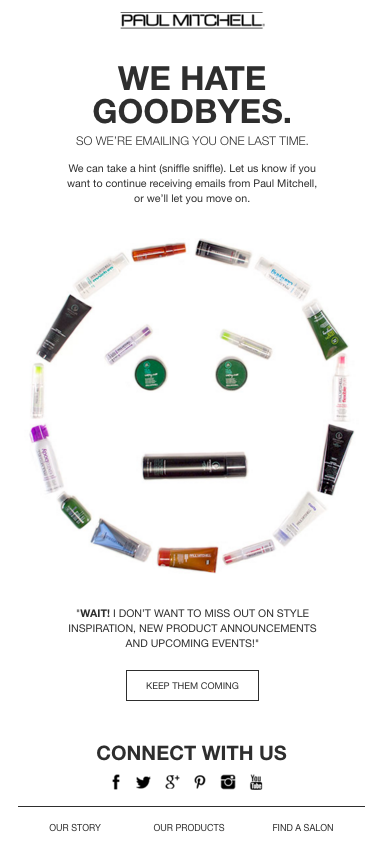
2. Avoid Spam Filters
Spam filters are those signals email service providers like Gmail and Outlook have programmed into their servers. These spam filters help them know if an email message is a spam.
The truth is that even your best emails can still be caught as spam. You need to know these spam filters if you really want to avoid them.
If your message is flagged as spam, your messages will be sent to the spam folder. It’s highly unlikely that a subscriber will check their spam folder and click your message.
Here are the practices that will ensure you don’t get into that spam folder:
- Recipients must opt-in to receive emails from you. Don’t sign up for anyone. Don’t send emails to anyone who didn’t give you their email on your website.
- Send emails from a good IP address. If you’re using a reputable email marketing service like the ones given above, you should have zero problems with your IP address.
- Send emails through a verified domain name. If you’re using your own domain name to send email messages to subscribers, ensure that your email has been verified. Verified domain names are more secured and unlikely to trigger a spam warning.
- Your HTML, CSS, and JavaScript should be clean. If you must format your emails, make sure the code is clean and follow standard practices. If you’re using an email marketing service, you don’t have to worry about that as they’ll take care of it for you.
- Ask subscribers to add your email to their address book. You can also show them how to do that. Emails that are added to your address book rarely lands in the spam folder.
- Don’t send salesy emails. I’m not saying you shouldn’t sell in your emails. Describe your product. Tell subscribers why it’s good. But don’t be aggressive. Avoid using words like “discount,” “cash,” “buy,” etc. It tells Gmail and Outlook that your email may be a spam.
- Don’t use deceptive subject lines. Email service providers do a great job at detecting deceptive subject lines. Emails that contain words like “URGENT,” “exclusive,” and “revolutionary” could be deceptive.
- Include your location in your email messages. The bottom of your message is a great place to add your business or P.O. Box address.
3. Send Email Messages at The Perfect Time
Getting the timing right is critical to achieving success with your email marketing campaign.
If you send emails at the wrong time, none of your subscribers will see your messages. Therefore, only a few of them may open your emails.
Of course, your goal is to ensure that your subscribers open your email messages. Subscribers won’t open your email if they aren’t online inside their inbox.
How do you figure this out?
Check some tests that have been done in your industry or related industries to know when subscribers open their emails.
Below are some tests you may find helpful.
MailChimp found that open rates are highest on Thursdays.
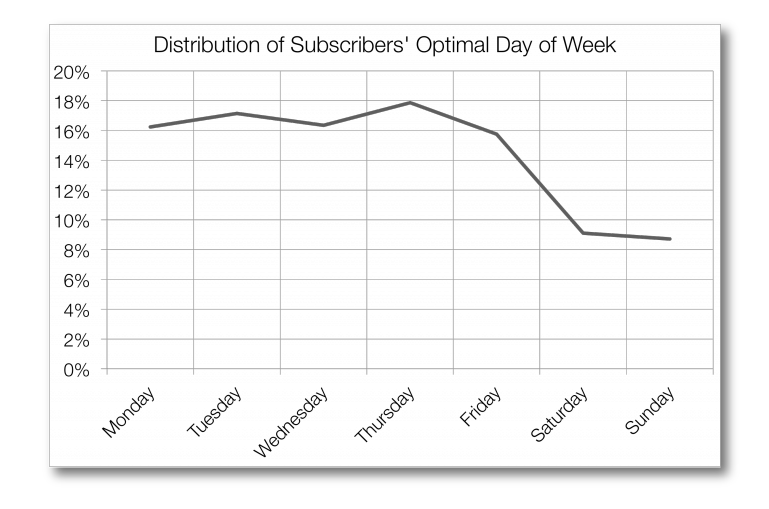
Looking at the above chart, any day from Monday to Friday looks good. You should avoid sending emails on Saturday and Sunday if you want to increase your email open rates.
When is the best time of the day to send emails?
Studies show that 10:00 a.m., 8:00 p.m., 2:00 p.m., and 6:00 a.m. are the best times to send emails.
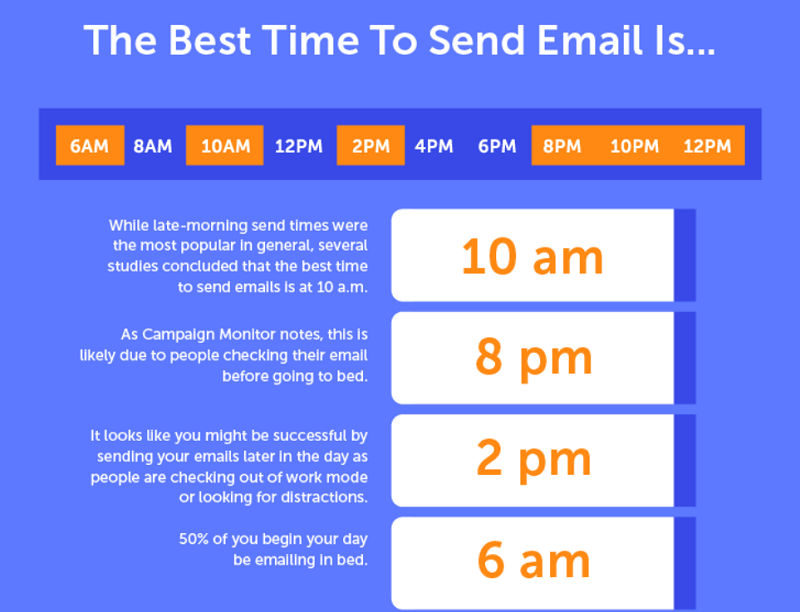
Ensure that you conduct your own tests to find the best time for you.
4. Make Your Subject Line Stand Out
The subject line is the first thing subscribers see when they see your message.
Make your subject line attractive. Remember that you’re competing with many other individuals and companies who also send email messages to your subscribers.
Write subject lines that make people curious and click on your email.
Use numbers. Numbers will draw the attention of your subscribers to your email message.
Make sure your subject lines are fun and sound like a conversation.
Use words your subscribers use daily.
5. Write Like A Friend
Your subject line and the message should sound like a note from a friend.
Don’t write using corporate words or terms. Don’t try to be too formal.
Sound personal. It makes your emails fun to read, and subscribers will see you as a friend instead of a marketer trying to sell them something.
6. Segment Your List
People will open your emails if it’s relevant to them. People can easily tell your email is relevant to them from reading your subject line.
When you segment your email list, you’ll be able to write subject lines that stand out and make subscribers open the email.
According to research by MailChimp, users who segment their email list enjoy more opens, clicks, and lower unsubs.
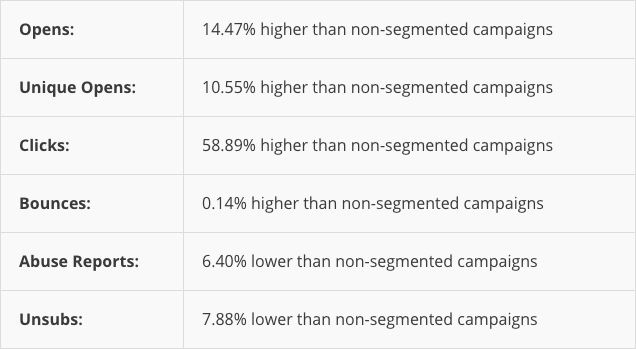
Conclusion
Any business can use email marketing to boost sales. Whether you sell products or services, you can use email marketing. According to 2Stallions, a renowned digital marketing agency, there are no alternatives to having a mailing list.
With a powerful tool like OmniKick, you can start gaining lots of subscribers today.
